 Open Access
Open Access
ARTICLE
DeepQ Based Automated Irrigation Systems Using Deep Belief WSN
Department of Computer Science and Engineering, MRK Institute of Technology, Cuddalore, 608301, Tamilnadu, India
* Corresponding Author: E. Gokulakannan. Email:
Intelligent Automation & Soft Computing 2023, 35(3), 3415-3427. https://doi.org/10.32604/iasc.2023.030965
Received 07 April 2022; Accepted 11 May 2022; Issue published 17 August 2022
Abstract
Deep learning is the subset of artificial intelligence and it is used for effective decision making. Wireless Sensor based automated irrigation system is proposed to monitor and cultivate crop. Our system consists of Distributed wireless sensor environment to handle the moisture of the soil and temperature levels. It is automated process and useful for minimizing the usage of resources such as water level, quality of the soil, fertilizer values and controlling the whole system. The mobile app based smart control system is designed using deep belief network. This system has multiple sensors placed in agricultural field and collect the data. The collected transmitted to cloud server and deep learning process is applied for making decisions. DeepQ residue analysis method is proposed for analyzing automated and sensor captured data. Here, we used 512 × 512 × 3 layers deep belief network and 10000 trained data and 2500 test data are taken for evaluations. It is automated process once data is collected deep belief network is generated. The performance is compared with existing results and our process method has 94% of accuracy factor. Also, our system has low cost and energy consumption also suitable for all kind of agricultural fields.Keywords
India has more than 80% depends agriculture lands and fields. The resources such as water, soil and fertilizer are the major key factors for improving irrigation and cultivation. The population growth is increased day by day and usage of agricultural more on demand. The science and technology is more helpful to this automated process with support of current IT and ITeS [1]. Currently many methods and systems are available to monitor the agricultural and cultivation lands. The advance system is also required to monitor soil, plants, temperature, humidity and also surveillance. Major key factors are monitoring and controlling the process and low cost services is required [2].
Automated monitoring system has low cost sensor and estimation of plant at different levels. Here plant leaf, plant levels, water level, moisture level and crop condition are taken. This is computer assisted service and enables store and decision making application [3]. Wireless Sensor network is internet based monitoring system which has weather, power, level and energy consumption which has microcontroller based communication devices. Nowadays plenty of applications are available for controlling household, industry and automation applications.
Prediction factor is key player for all kind of process in our case agriculture and crop filed reduce the overhead time and increase accuracy. The sensor is placed in crop or cultivation field and data can be transmitted using Zigbee protocol [4]. This is internet based service offering and retrieval process monitoring systems. The system reacts abnormal conditions and critical issues. The surveillance system is well placed and wireless camera is activated while any attack or dematerialized zones. Sensor networks are used for security related services and most of them used for industry environments [5]. Data acquisition is certainty factor because data can be captured and processed means it has time consuming. All the sensitive information is to be collected so the deep learning process is required. In this paper, Section 2 explains about various literature reviews, Section 3 gives automation process and formulation, Section 4 deals experimental results and simulations, Section 5 gives conclusion and improvements.
In environment aware applications sensor has placed in monitored place and measure the parameters. Wong et al., soil and temperature are the major resource and wireless senor network is needed in appropriate places. This case commercial networks implement with low power but efficiency also reached lower only. Such cases wireless sensor networks and embedded processors are suggested [6,7]. Chizao et al. the modern computing systems are designed with low power consumption and wireless services are required to handles data. Normally radio frequency modems are available with good accuracy rate but it consumes more power.
Jannesari et al., the two IEEE standards Wi-Fi and Wireless Personal Network are established wide area network with less coverage constraints [8]. The Bluetooth based communication medium also available to handles the data processing. As per suggestion received from Wang et al., the coverage area also required to data and it is cover major places [9]. So Zigbee based services are enabling more coverage area and controlling the environment. Data capturing is another factor because we need measure temperature and soil values. So, the system must be designed capable all the parameters.
The sensors like soil moisture, humidity, temperature, light effect and water level are connected with controller. It senses the data and transmitted to server [10,11]. Zigbee based services has Wireless Sensor network coverage and it is represented by Zunga et al. As the survey from Scopus in the year 2020, the industries are moving to implement automation process in agricultural lands to monitor the process [12,13]. The specialized IoT enabled services are formulated and making uninterrupted communication. The data can be captured from multiple sources and sensor detects all the inputs.
The collected data are recorded in excel sheet and MATLAB tool is used for data analytics process which has be done by Alexa net model in 2018 [14]. Nowadays unstructured data are received and different inbuild sensors are available. Embedded components are replaced by IoT services. So, we need to do intelligent based services for handling data operations [15]. So, we proposed Deep belief network based operation and services for automated irrigation process and monitoring system.
3 Automated System Design and Process
Human life depends only agriculture and sufficient amount man power and resource are required to provide good products. Many a time human dependence always questionable so some of the works are automated and controlled by agent or services means we will reduce the man power as well as increase the efficiency. This is automated irrigation system with the combination of man power and machine based operations. It is required and allows to handle plenty of applications.
Our country depends agriculture is the major income and also financial growth rapidly increased. So the technology based assisting system also support and helpful for the country. Here we are implementing automation irrigation system to monitor and control the agriculture process. The below Fig. 1 shows that system architecture wireless sensor network components. Our system has wireless sensor unit, wireless information unit and data management unit.
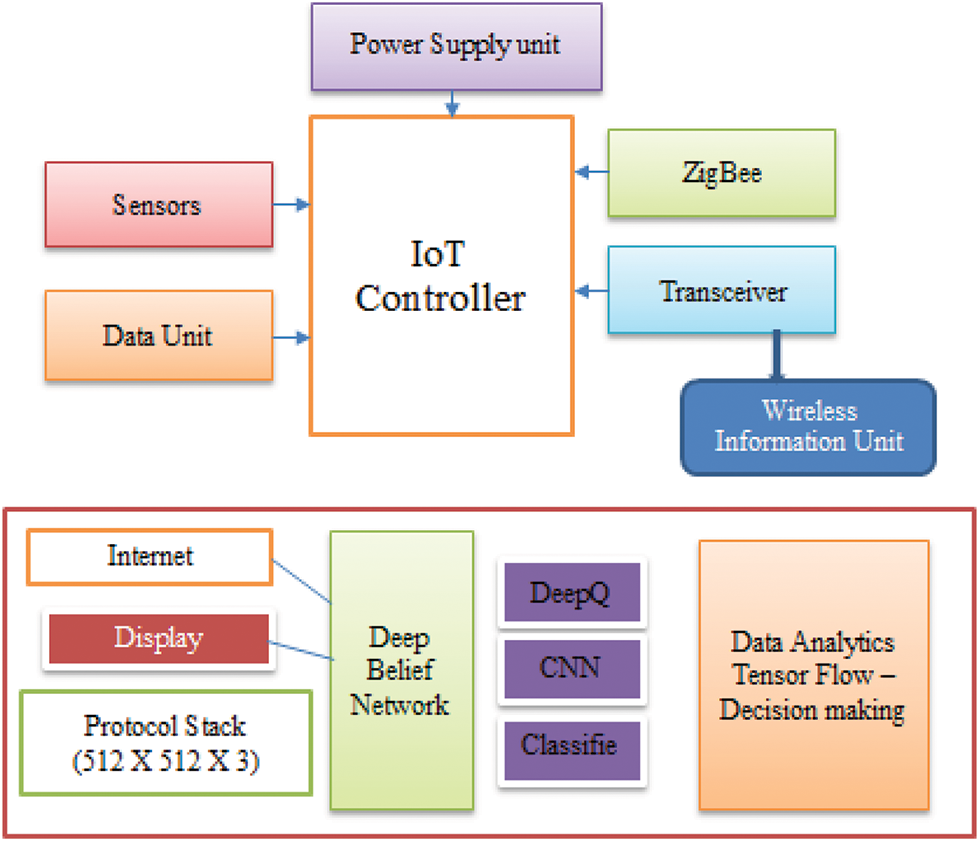
Figure 1: Wireless personal network components
This is automated process and it has wireless sensor unit part to take input from sensor data like soil moisture, temperature, light data and water level. The ZigBee protocol is used to transfer the data. Based on input it is stored in cloud server and generate Deep belief network. Internet is used for data transmission and Wi-Fi is used for uninterrupted internet services. The data analytics process is done and result is accessed by smart technologies such as smartphone, smart devices, etc.
The data are stored in cloud server and TensorFlow tool is used for simulations. Here the dataset are divided into pieces of code from 10000 trained data and 2500 with respect to 512 × 512 × 3 layer system. The input is represented as (F(TR,TD)) where TR–Trained dataset and TD–Test Dataset. The final output is deep belief network with decision and accuracy index represented in Fig. 2.

Figure 2: Deep belief network formation
4 Experimental Setup and Simulations
Let as take F is the functional index received dataset from server and collected from sensor devices F € {TR,TD}. Fig. 3, from this X set of input is represented as F(x) as {xo, x1,….,xn–1} and accuracy index is calculated as follows,
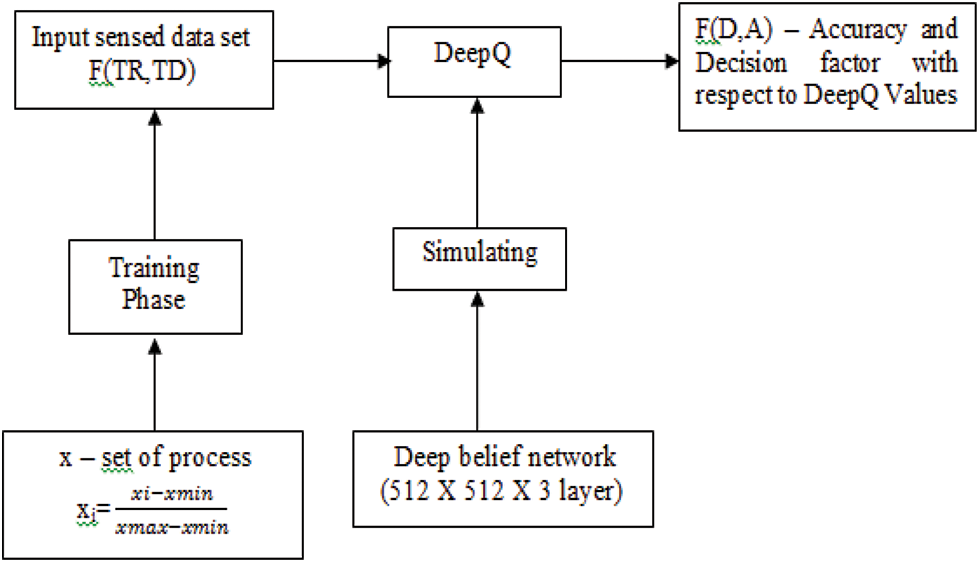
Figure 3: Decision and accuracy factor calculation
So the Decision factor is calculated by using trained data
The model is fully connected mode and mutation process calculating hidden layer calculation. The mutual data processing is represented as M, regularizing factor is represented as λ and decision making factor is D, from this
where
Based on above representation automation process is followed by flowchart and algorithm is also represented in below
From Tab. 1, input data are selected and apply the deep learning process using TensorFlow. Multiple iterations are performed based on this accuracy and decision factor are recorded in Fig. 4.

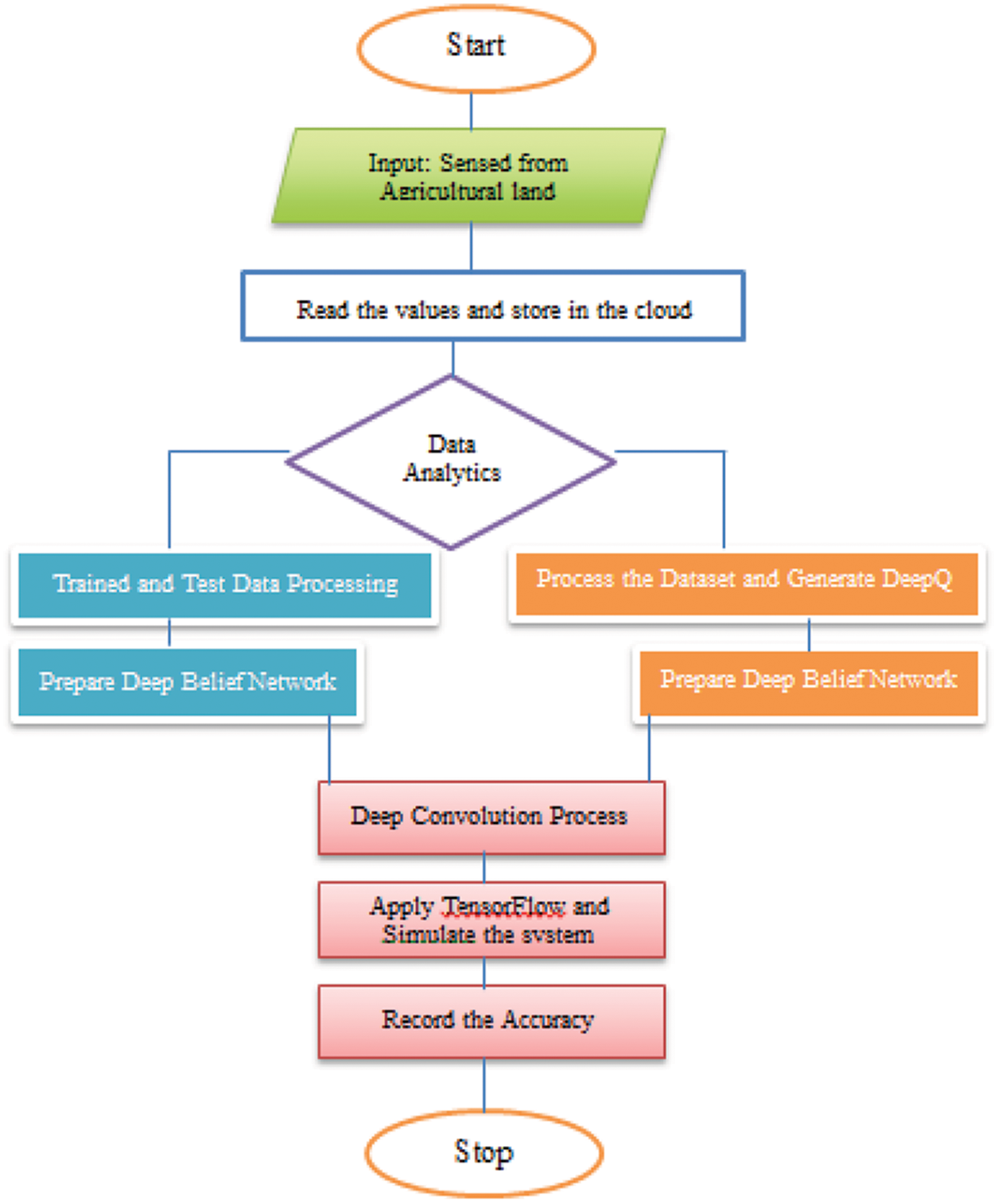
Figure 4: Flowchart for deep belief network model and processing

The below graphs are taken from TensorFlow about the results of accuracy index, coverage constraints and sensor optimization from various cluster node based on Figs. 5 and 6.
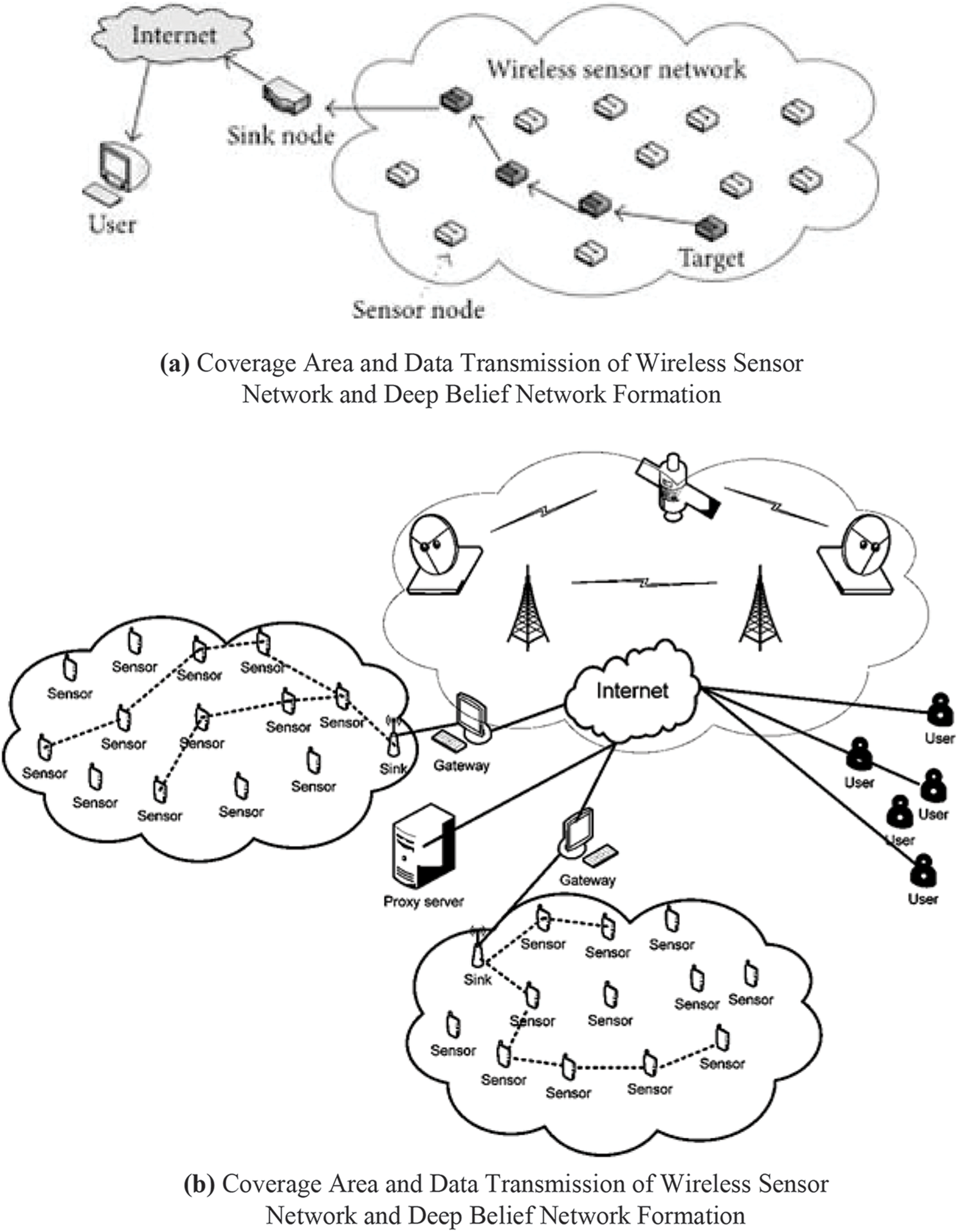
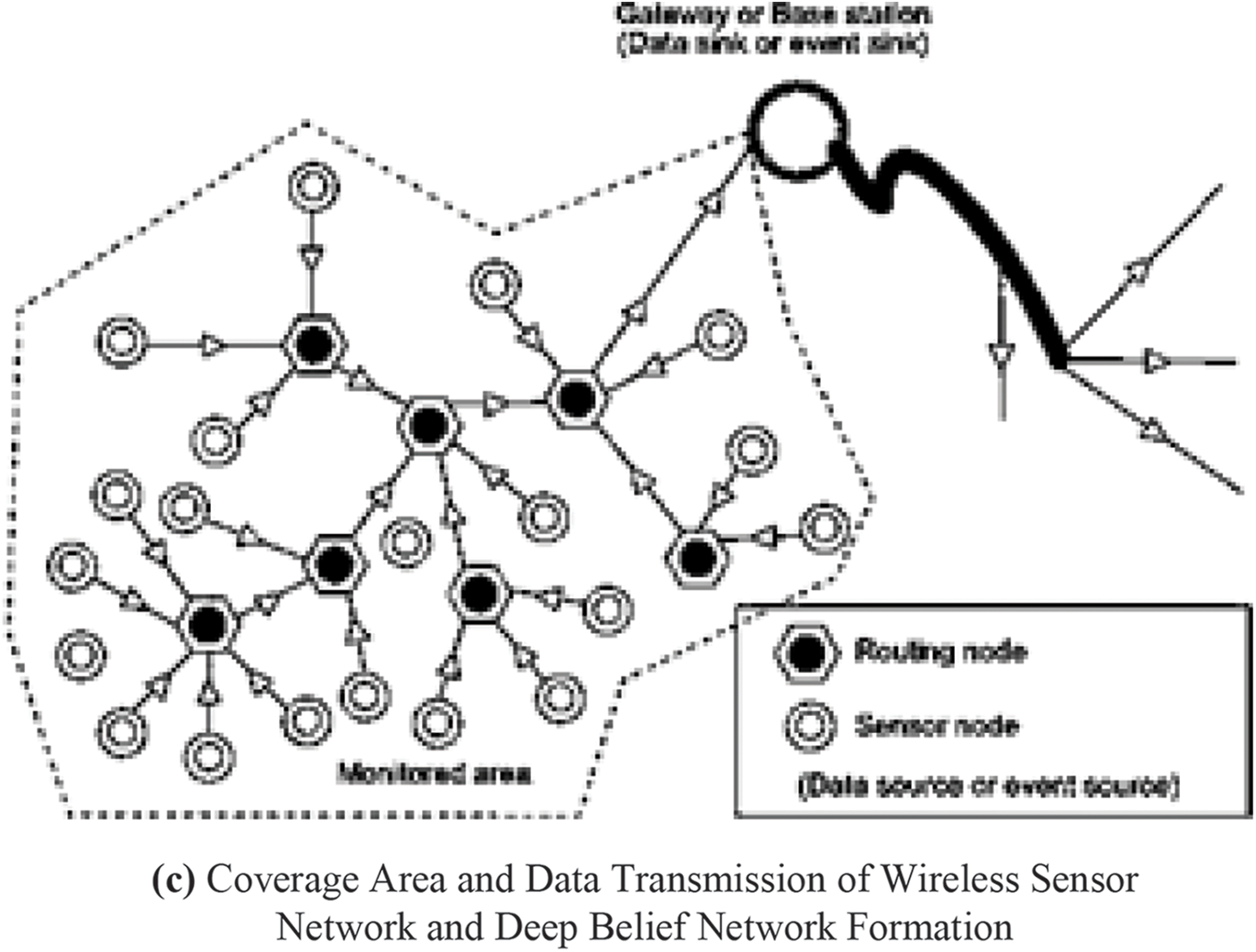
Figure 5: (a–c) Coverage area and data transmission of wireless sensor network and deep belief network formation
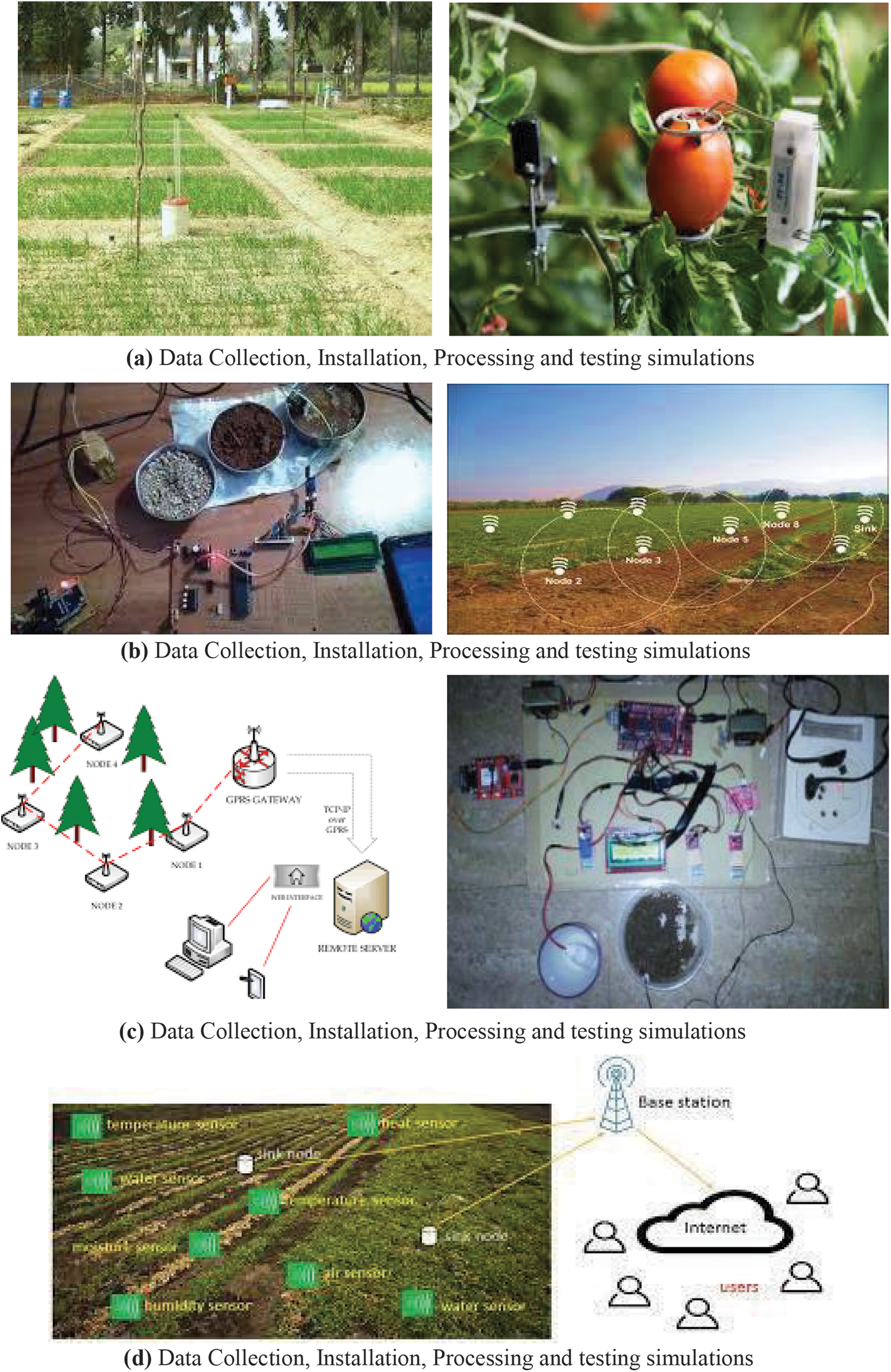
Figure 6: (a–d) Data collection, installation, processing and testing simulations
The simulations are done by using TensorFlow and experiments are carried out. The Deep belief Wireless network is generated and graphs are shown various results. The graphs are shown above Fig. 7 the routing is results for calculating coverage area accuracy factors. While increasing number of nodes based on iteration coverage results are updated shown in Tab. 2. The data delivery factor, delay and energy consumption also recorded. The results are compared with various tools and our proposed system has 94% of accuracy. The below Tab. 3 shows that comparison of existing methods accuracy factor.

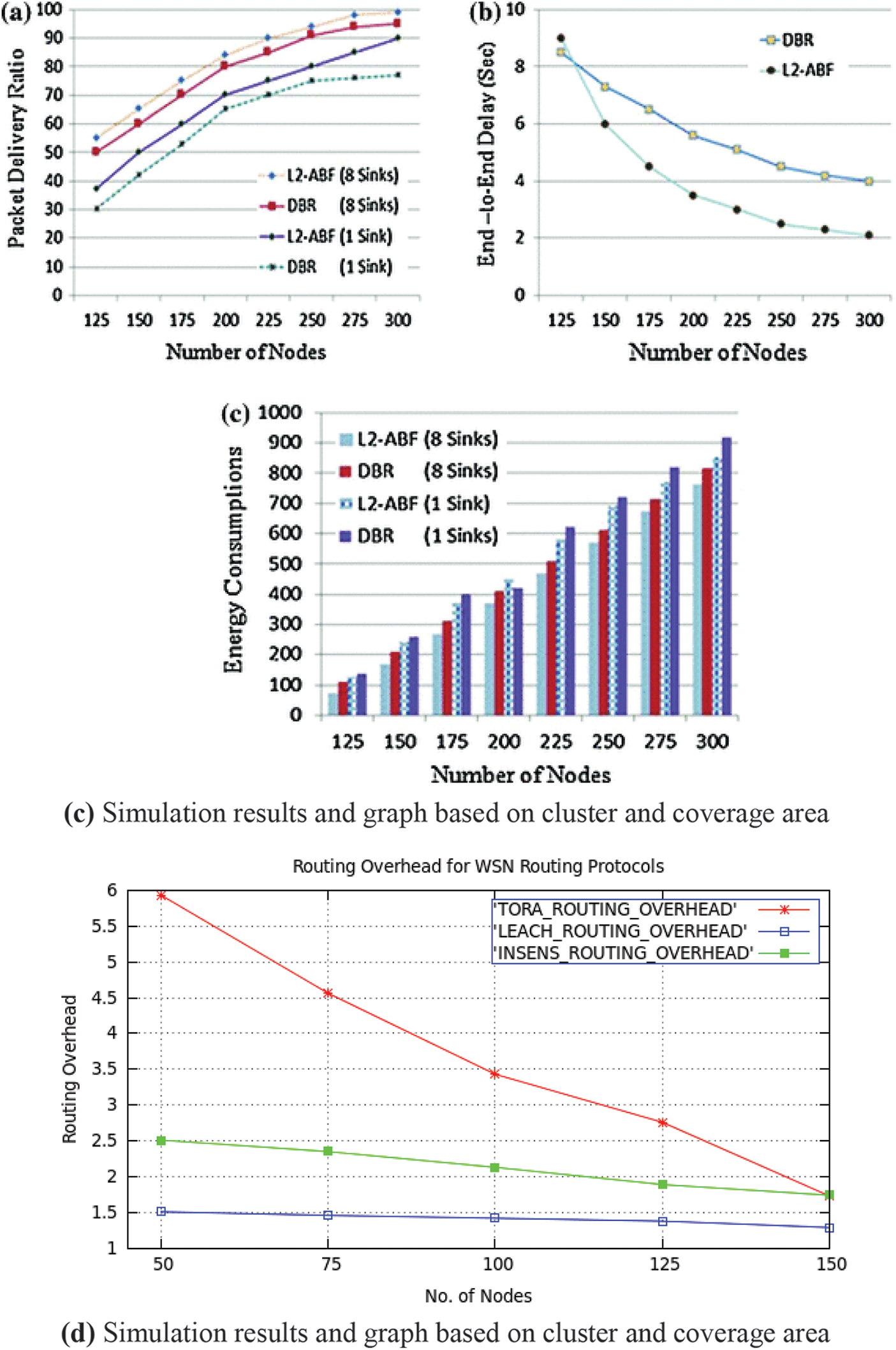
Figure 7: (a–d) Simulation results and graph based on cluster and coverage area


The above table’s shows that comparison of existing method from this our proposed Deep Belief Wireless Sensor Network provides better accuracy result.
Farming and agriculture is major key player for our Indian economy. Science and Technology development leads major role to increase the economical growth. We implemented automated irrigation process and monitoring system. We proposed DEEPQ based residue analysis system to detect cultivation land and measure the contents. It is IoT enabled monitored system and data stored cloud. Data analytics process is applied for decision making capabilities. The automated system is used to monitor the land and cultivate the process. The performance is recorded and compared with existing system. Our proposed system has the accuracy as 94% and in future deep belief wireless sensor network method will be suggested from building smart cities and smart environments.
Funding Statement: The author received no specific funding for this study
Conflicts of Interest: The author declares no conflicts of interest to report regarding the present study.
References
1. S. Manikandan and M. Chinnadurai, “Effective energy adaptive and consumption in wireless sensor network using distributed source coding and sampling techniques,” Wireless Personal Communication, vol. 118, pp. 1393–1404, 2021. [Google Scholar]
2. Z. Ma, N. Nuermaimaiti and L. Wang, “Performance analysis of d2d-aided underlayingcellular networks based on poissonhole cluster process,” Wireless Personal Communications, vol. 111, pp. 2369–2389, 2020. [Google Scholar]
3. S. Manikandan and M. Chinnadurai, “Virtualized load balancer for hybrid cloud using genetic algorithm,” Intelligent Automation & Soft Computing, vol. 32, no. 3, pp. 1459–1466, 2022. [Google Scholar]
4. M. Afshang, H. S. Dhillon and P. H. J. Chong, “Modeling and performance analysis of clustered device-to-device networks,” IEEE Transactions on Wireless Communications, vol. 15, no. 7, pp. 4957–4972, 2016. [Google Scholar]
5. A. Y. Betul, K. Zeynep, D. Mehmet and A. Galip, “A visual similarity recommendation system using generative adversarial networks,” in Int. Conf. on Deep Learning and Machine Learning in Emerging Applications (Deep-ML), Singapore, vol. 104, pp. 1192–1221, 2019. [Google Scholar]
6. J. Yan, M. Zhou and Z. Ding, “Recent advances in energy-efficient routing protocols for wireless sensor networks: A review,” IEEE Access, vol. 4, pp. 5673–5686, 2016. [Google Scholar]
7. K. Manikanda Kumaran, M. Chinnadurai, S. Manikandan, S. Palanimurugan and E. Elakiya, “An IoT based green home architecture for green score calculation towards smart sustainable cities,” KSII Transactions on Internet and Information Systems, vol. 15, no. 7, pp. 190–212, 2021. [Google Scholar]
8. A. Jannesari, M. A. Sarram and R. Sheikhpour, “A novel network coding algorithm to improve tcp in wireless networks,” Wireless Personal Communications, vol. 110, no. 3, pp. 1199–1216, 2020. [Google Scholar]
9. J. Wang, Y. Gao, X. Yin, F. Li and H. J. Kim, “An enhanced PEGASIS algorithm with mobile sink support for wireless sensor networks,” Wireless Communications and Mobile Computing, vol. 115, no. 10, pp. 982–1002, 2018. [Google Scholar]
10. R. Renugadevi and K. Vijayalakshmi, “Modeling a novel network coding aware routing protocol for enhancement of network performance in wireless mesh network,” Wireless Personal Communications, vol. 118, no. 1, pp. 891–903, 2019. [Google Scholar]
11. J. Wang, Y. Gao, W. Liu, W. Wu and S. J. Lim, “An asynchronous clustering and mobile data gathering schema based on timer mechanism in wireless sensor networks,” Computers Materials & Continua, vol. 58, no. 3, pp. 711–725, 2019. [Google Scholar]
12. C. Szegedy, V. Vanhoucke, S. Ioffe, J. Shlens and Z. Wojna, “Rethinking the inception architecture for computer vision,” in Proc. of the IEEE Conf. on Computer Vision and Pattern Recognition, Las Vegas, NV, USA, vol. 10, pp. 191–198, 2016. [Google Scholar]
13. T. Gui, C. Ma, F. Wang and D. E. Wilkins, “Survey on swarm intelligence-based routing protocols for wireless sensor networks: An extensive study,” in IEEE Int. Conf. on Industrial Technology (ICITChina, pp. 1944–1949, 2016. [Google Scholar]
14. B. Yin, S. W. Zhou, S. W. Zhang, K. Gu and F. Yu, “On efficient processing of continuous reverse skyline queries in wireless sensor networks,” KSII Transactions on Internet and Information Systems, vol. 11, no. 4, pp. 1931–1953, 2017. [Google Scholar]
15. J. M. Zhang, K. Yang, L. Y. Xiang, Y. S. Luo, B. Xiong et al., “A self-adaptive regression-based multivariate data compression scheme with error bound in wireless sensor networks,” International Journal of Distributed Sensor Networks, vol. 9, no. 3, pp. 913497, 2013. [Google Scholar]
Cite This Article
 Copyright © 2023 The Author(s). Published by Tech Science Press.
Copyright © 2023 The Author(s). Published by Tech Science Press.This work is licensed under a Creative Commons Attribution 4.0 International License , which permits unrestricted use, distribution, and reproduction in any medium, provided the original work is properly cited.


 Submit a Paper
Submit a Paper Propose a Special lssue
Propose a Special lssue View Full Text
View Full Text Download PDF
Download PDF Downloads
Downloads
 Citation Tools
Citation Tools